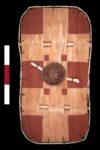 University of Leicester archaeologists have discovered an Iron Age bark shield, the first of its kind ever found in Europe. It was made sometime between 395 and 255 B.C., the Middle Iron Age.
University of Leicester archaeologists have discovered an Iron Age bark shield, the first of its kind ever found in Europe. It was made sometime between 395 and 255 B.C., the Middle Iron Age.
The shield was found in 2015 during an archaeological survey at the site of the Everards Meadows development in the Soar Valley south of Leicester. It was buried face down in a deep waterlogged pit, which is why the barks and wood it was made out of survived the centuries. The pit was probably a watering hole for livestock before the shield was deposited; the excavation discovered a trackway, ditches and land boundaries indicating the site was likely used in stock rearing by the small farmsteads in the community.
The shield, which measured 670 x 370mm [26.3 x 14.6 inches] in the ground, is unique, the only bark shield every found in Europe. It was carefully constructed with wooden laths to stiffen the structure, a wooden edging rim, and a beautiful woven boss to protect the handle. The outside of the shield was painted and scored in red chequerboard decoration.
Detailed analysis shows that the bark was from either alder, willow, poplar, hazel or spindle tree with the outer layer of bark forming the inside of the shield. The stiffening laths were made of apple, pear, quince or hawthorn whilst the rim was a half-split hazel rod. Analysis to date suggests that the boss was formed from a willow core stitched together with a flat fibre of grass, rush or bast fibre, and the handle was of willow roundwood, flattened at the end and
notched, and fixed to the bark with twisted ties. The outer surface of the shield was scored with lines forming a chequerboard pattern, with parts painted with red hematite-based paint.
The shield was severely damaged before being deposited in the watering hole. Analysis by Dr Rachel Crellin (School of Archaeology and Ancient History, University of Leicester) suggests at least one irregular elliptical hole was likely to have been damage caused by the pointed tip of an iron spear, whilst other groups of parallel incisions may show where edged blades have hit and rebounded. Further research is planned to help understand if this occurred in battle or as an act of ritual destruction.
 The discovery of this shield rewrites the history of weaponry in Iron Age Britain. Before now, bark shields had only been found in the southern hemisphere and historians believed they were simply not used in the northern hemisphere. The damage to the Enderby Shield indicates that they were indeed made as weapons of war, and experimental recreations have confirmed that evenly though it was only a tenth of an inch thick and incredibly lightweight, the reinforced bark shield was strong enough to withstand projectile impact.
The discovery of this shield rewrites the history of weaponry in Iron Age Britain. Before now, bark shields had only been found in the southern hemisphere and historians believed they were simply not used in the northern hemisphere. The damage to the Enderby Shield indicates that they were indeed made as weapons of war, and experimental recreations have confirmed that evenly though it was only a tenth of an inch thick and incredibly lightweight, the reinforced bark shield was strong enough to withstand projectile impact.
The recreation of willow and alder bark shields also found that they could be manufactured quickly and easily using materials from a local woodland and a few simple tools. The finished shields varied in shape because of the wood elements shrank and curved as they dried. Built as rectangles, once they were dry they had hourglass shape, a design seen in some metal shields from the period.
It’s not clear why the shield was in the bottom of the watering hole – perhaps it was thrown away because it was broken, or perhaps it was deliberately placed there as a ritual act. Radiocarbon dates for the shield and for other material in the watering hole suggest that more than a decade had passed between the shield’s manufacture and its disposal. The damage to the shield may well hold the answer to this question.
I can’t see the reasoning why anyone would believe that the bark shield would not be used in an adjacent area.
If the technology is good I’d think it will spread.
very cool
Never embark with your shields down.